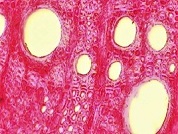Variation in Bulnesia retama (Zygophyllaceae) secondary xylem traits along an aridity gradient in central-western Argentina
DOI:
https://doi.org/10.14522/darwiniana.2021.91.929Keywords:
Arid lands, cross-section area, environmental gradient, xylematic traitsAbstract
The study of secondary xylem of Bulnesia retama along an aridity gradient allowed finding variations among different xylem cell types that can be used to predict tolerance of this species to aridity. The aim of this work was to carry out an anatomical description of the secondary xylem through cross sections, to analyse the variation of traits considered to be important for survival in arid environments, such as the percentage of vessels, fibres and parenchyma, fibre wall thickness, and wood density. The samples were obtained from primary branches of plants from four locations along an aridity gradient (Médanos Grandes, Bermejo, Marayes and Chepes, San Juan and La Rioja provinces, Argentina). Cross sections were observed with optical microscope and resulting digital images were analysed with ImageJ software. The results indicate that vessels are small, numerous and diagonally distributed, axial parenchyma is apotracheal diffuse. A significant increase in total fibre area and a decrease in parenchyma area with increases in aridity were observed. Total vessel area did not show any changes, while fibre wall thickness increased slightly with aridity. These traits suggest that B. retama has a highly drought-tolerant wood showing phenotypic plasticity along the aridity gradient, also registering a high-density xeromorphic wood.

Downloads
Published
How to Cite
Issue
Section
License

Starting on 2012, Darwiniana Nueva Serie uses Licencia Creative Commons Atribución-NoComercial 2.5 Argentina .





